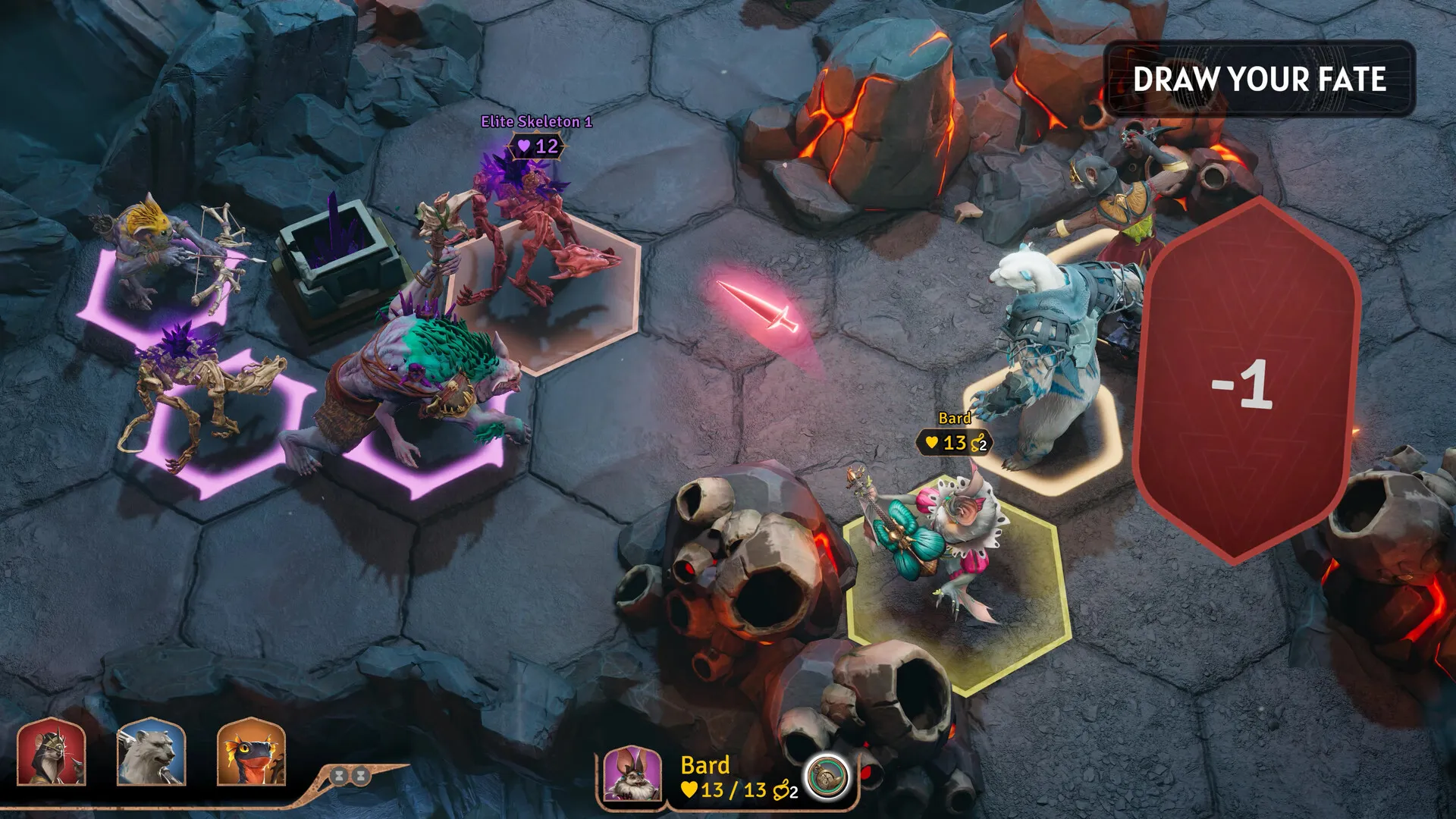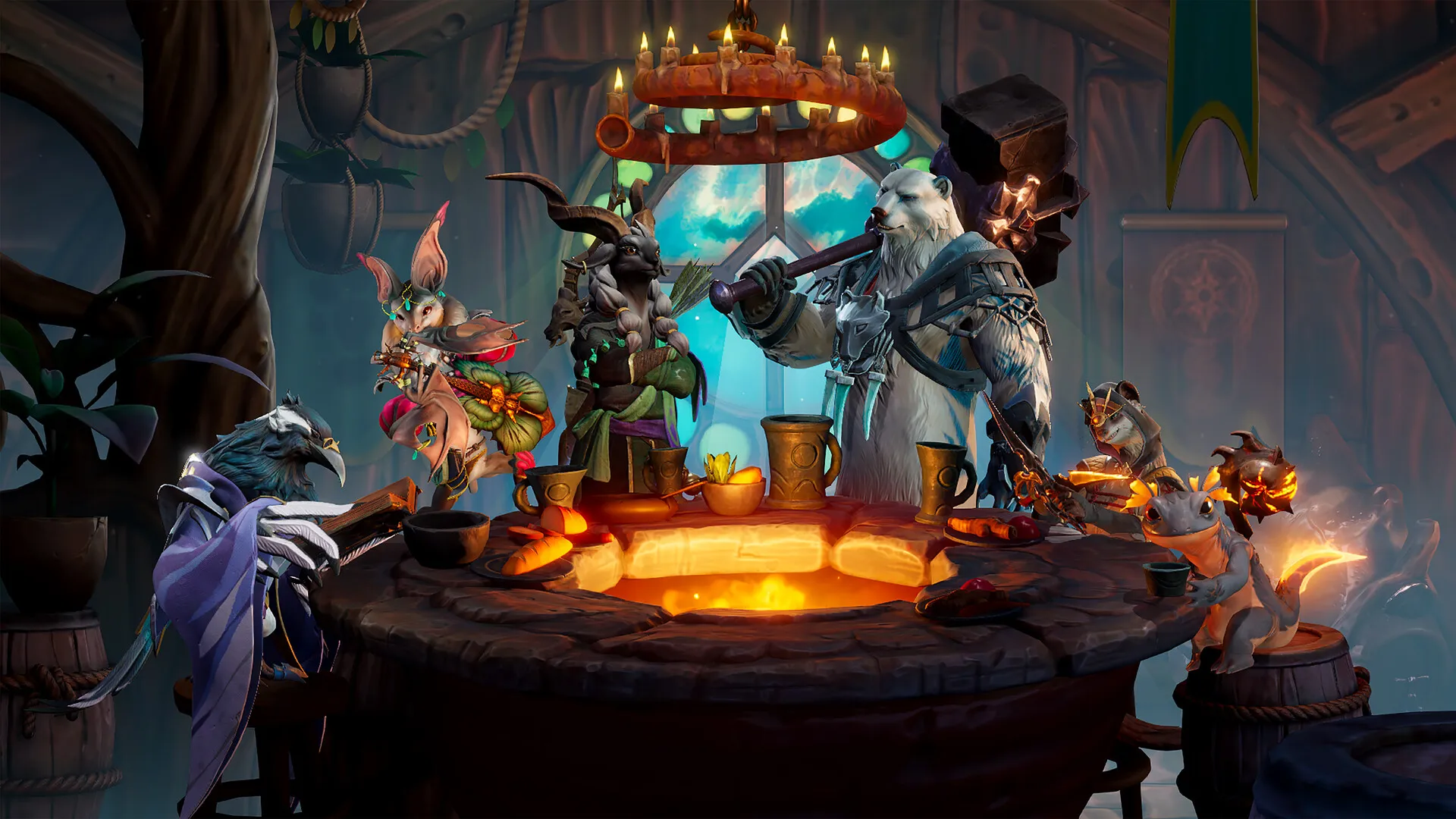Sunderfolk is a turn-based tactical RPG that channels the feel of a tabletop session straight to your living room. Developed by Secret Door under Dreamhaven—Mike Morhaime’s new studio—this title is available on PC, PlayStation 5, Switch, and Xbox Series X|S. Its design echoes classics like Fire Emblem in strategic depth and XCOM in battlefield pacing, but it simplifies setup and rules so newcomers can dive in without a rulebook avalanche.
At its heart, you choose one of six anthropomorphic heroes—from a gravity-wielding arcanist crow to a stealthy weasel rogue—to defend Arden’s magical tree from a creeping corruption called shadowstone. Each character brings distinct abilities and a customizable card deck that evolves as you gain levels, ensuring that every playthrough feels fresh whether you’re exploring murky caves or fending off enchanted beasts.
What sets Sunderfolk apart is its free companion app on phones or tablets, which players use to map movements and select actions while the main action unfolds on your TV or monitor. This control scheme encourages players to discuss tactics—much like a tabletop group huddled over a board—and strikes a balance between accessibility for casual gatherings and enough complexity to satisfy seasoned strategy fans.
Core Gameplay Mechanics
Sunderfolk’s tactical framework unfolds on a vibrant hex grid reminiscent of classics like Battle Brothers or Gloomhaven, but with a top-down camera that keeps every hero and hazard in view. Rather than a fixed initiative order, players decide the turn sequence each round—if your rogue needs to dart through webs before your arcanist pulls foes into a gravity well, you simply take your turn first. This flexibility rewards real-time strategy discussions and mirrors the give-and-take of tabletop RPGs more closely than the rigid systems found in games such as XCOM.
At the heart of each hero’s toolkit lies a custom deck of ability cards. Early on, you’ll juggle three starter cards; by mid-game, you might have half a dozen, requiring you to bench older moves to make room for powerful new ones. Take the arcanist’s teleport card: it shifts your hero two spaces and grants extra mana based on nearby enemies, setting up devastating follow-up turns. Managing mana and parsing cards with multi-action sequences—move, attack, then reposition—adds a layer of resource juggling akin to Slay the Spire, yet here it plays out cooperatively against coordinated enemy waves.
Crucially, Sunderfolk leans on its mobile-app controller to bring these mechanics to life. On your phone or tablet, you trace your hex-to-hex path, tap to select targets, and browse tooltips without cluttering the main screen. For remote sessions, the coordination mode projects a shared cursor, letting off-site players sketch tactics just as if they were leaning over the table. The touch controls feel polished and responsive—far smoother than early attempts at companion apps in board-game hybrids.
Missions themselves stray from kill-everything objectives. You’ll escort an injured penguin through winding caverns, defend a chokepoint against swarms of corrupted critters, or race to unlock a gate before time runs out. Environmental hazards—lava pools that scorch your pyromancer or sticky webs that snare your ranger—keep each map fresh, while one-use items like healing potions or throwable bombs offer clutch turn-saving plays. This mix of objectives and interactive terrain ensures no two encounters ever feel identical.
Cooperative Multiplayer & Social Dynamics
Sunderfolk shines brightest when shared with friends, supporting two to four players—solo adventurers simply split control among at least two heroes. Missions wrap up in under thirty minutes, making it easy to squeeze in a quick session or linger over tactics without a huge time investment. This pick-up-and-play design slots neatly into a weekend gathering, much like a board-game one-off but with digital polish.
Teamwork isn’t just encouraged—it’s essential. Heroes are built to complement each other: the arcanist’s Gravity Well can cluster enemies for a pyromancer’s firestorm, while the bard’s buffs amplify the ranger’s piercing strikes. These synergies recall party combos in Divinity: Original Sin 2, but Sunderfolk keeps the flow tighter by letting you map out moves on your phone, then watch them execute in unison on screen. Whether you’re coordinating a multi-card sequence or trading cards to shore up resources, each player’s choice ripples through the team.
Communication adapts to your setup. Couch play turns into lively finger-pointing as teammates shout planned maneuvers. Remotely, the coordination mode projects a shared cursor, so players on Discord can sketch battle plans just as effectively—no awkward “You’re up next” moments. If someone starts mapping their turn prematurely, a quick exit lets another player jump in first, preserving momentum and collaborative spirit.
Beyond tactics, Sunderfolk fosters memorable group anecdotes. Naming a newly built bridge or christening the turret-like insect guard dogs embeds your party’s flair into Arden’s lore. One group’s decision to name an enemy “Sir Fluffles” led to weeks of in-game callbacks, underscoring how player-driven moments become lasting stories. In that sense, Sunderfolk doesn’t just simulate teamwork—it turns every session into a shared narrative.
Narrative, World & Characters
Sunderfolk’s narrative unfolds in the idyllic village of Arden, home to a life-giving tree whose roots radiate protective magic. When a creeping corruption known as shadowstone begins to taint both flora and fauna, six former tavern bouncers answer the call to defend their home. The simplicity of this setup mirrors the classic “call to adventure” in Dragon Age: Origins, but Sunderfolk keeps exposition lean—major plot beats arrive between missions, letting the player glide from one tactical encounter to the next without long cutscenes.
The campaign arc moves predictably from tavern rough-and-tumble to high-stakes heroism, yet it maintains momentum by weaving narrative moments into gameplay. After a mission, you return to Arden’s hub to explore short, silent dialogue branches on your device; every line you click through is trimmed compared to the voiced flashpoints delivered by Anjali Bhimani. This balance echoes Divinity: Original Sin 2’s mix of text and voice, though Sunderfolk limits each visit to three conversations per player—forcing choices that boost replay value by making every dialogue decision feel finite.
Character relationships hinge on those conversation caps. Befriending Amaia, the one-armed penguin orphan, demands prioritizing her over other townsfolk—echoes of Persona’s social links—while romance options unfurl only if you invest early. These branching paths reward multiple playthroughs, as different allies emerge and unique cutscenes trigger based on your choices.
Central to Arden’s life is Bhimani’s “Game Master” performance. She slips seamlessly between a gravelly dwarven miner, a timid herbalist, or a conniving uncle, shifting pitch and accent so subtly that you feel you’re sitting at a real tabletop session. Her vocal dexterity brings even minor NPCs to life, turning otherwise straightforward quests into emotionally charged encounters and deepening your investment in both friends and foes.
Progression Systems & Customization
Progress in Sunderfolk hinges on a tight cycle of experience gain and deck evolution. After each mission, heroes earn XP quickly—often enough to level up every two or three encounters—and each level unlocks a new ability card. Early on, you juggle just three equipped cards; by mid-game, you may have six or more, forcing you to bench older moves. Deciding which cards to rotate out mirrors the choices in Slay the Spire, but here the emphasis is on cooperative synergy: swapping in a high-mobility rogue dash may dovetail perfectly with a berserker’s crowd-control smash in the next fight.
Beyond cards, each hero’s arsenal expands through weapons, trinkets, and consumables. Weapons come with upgrade paths and unique triggers—for example, the berserker’s hammer deals bonus damage only after enduring an enemy blow, echoing risk-reward mechanics in Darkest Dungeon. Trinkets offer one-off effects like teleporting an ally or weakening an enemy’s armor, lending clutch utility in tight spots. Meanwhile, food and beverages purchased in Arden’s tavern grant temporary resistances—lava-proof ale or fire-retardant pastries—that feel like classic RPG buff potions but require forethought based on upcoming hazards.
Back in Arden, progression takes on a communal dimension. Players pool gold and materials to erect or upgrade buildings, unlocking new shops, NPCs, and even additional cards to purchase. With each visit capped at three conversations per player, choosing which shopkeeper to speak with or which building to fund becomes a strategic decision akin to managing social links in Persona. The group then votes on the next mission, making town-building itself feel like a shared mini-game and reinforcing collective investment in Arden’s growth.
This layered progression system ties directly into replayability. With only 38 missions available per campaign and limited dialogue slots, you’ll miss characters, romance arcs, or side stories on your first run. Naming seeds or guards embeds your choices into future playthroughs, ensuring each run reflects your party’s personality. And with the development team hinting at DLC expansions, these systems promise fresh customization paths long after the initial campaign wraps up.
Presentation, Technical Performance & Accessibility
Sunderfolk’s visual design marries a board-game aesthetic with clean 3D models, striking a balance between tabletop charm and digital polish. The hex grid and character miniatures on screen echo physical tokens, while animations—spells arcing across the battlefield or a hero’s victory pose—move smoothly without distracting from tactical decision-making. Cutscenes, however, lean on simple camera pans and sparse environmental detail, giving them a functional feel that contrasts with the richly voiced dialogue moments.
Audio design plays a key role in reinforcing both tension and whimsy. A subtle, pulsing score underscores combat phases, then shifts to light, melodic themes in Arden’s streets. Sound effects are crisp: flipping ability cards produces a satisfying click, elemental spells crackle with weight, and environmental hazards—like lava bubbling or webs snapping—alert you just in time to adjust strategy. This sound layering recalls the dynamic atmospherics of XCOM 2, albeit on a more intimate scale.
Performance remains rock-solid across PC and consoles. Load times hover around ten seconds, and frame rates sit consistently at 60 fps even during large-scale skirmishes. I encountered only one hiccup—a brief control-app freeze that resolved after restarting the session. Accessibility shines through customizable difficulty settings, from forgiving modes that ease resource management to tougher tiers demanding precise coordination.
In-game tutorials guide new players through card mechanics, and tooltips explain every icon. Quality-of-life features—auto-leveling late-join heroes and the ability to cancel a mapped move before execution—ensure Sunderfolk welcomes both strategy veterans and first-time tacticians alike.
The Review
Sunderfolk
Sunderfolk captures the camaraderie and strategy of a tabletop session with polished turn-based tactics, intuitive phone controls, and a charming cast—despite modest cutscene visuals and a straightforward story. Its deckbuilding depth, cooperative synergies, and strong performance make it an ideal gateway for both newcomers and veterans.
PROS
- Engaging cooperative tactics with flexible turn order
- Deep yet approachable card-based ability system
- Intuitive and responsive mobile-app controls
- Rich voice acting by Anjali Bhimani
- Strong performance across platforms with minimal load times
CONS
- Modest cutscene visuals and sparse environmental detail
- Limited mission pool and dialogue slots per run
- Pacing can drag during repetitive objectives
- Story stays relatively straightforward without major twists




















































